Article Critique: Student Nurse Perceptions of EBP and Research
VerifiedAdded on 2022/11/22
|9
|2316
|322
Report
AI Summary
This article critique analyzes the study by Brooke, Hvalič-Touzery, & Skela-Savič (2015), which explored student nurses' perceptions of evidence-based practice (EBP) and research. The study, conducted with students from the University of Greenwich, England, and the Faculty of Health Care Jesenice, Slovenia, employed a qualitative research design using interpretative phenomenological analysis. Data collection involved open-ended interviews with 70 participants across different years of the nursing program. The findings revealed four key themes: EBP providing confidence and empowerment, its importance in improving patient safety, its role in developing nursing as a profession, and the development of research skills. The study highlighted differences in perceptions between students from the UK and Slovenia, emphasizing the need for active involvement of students and practicing nurses in research and the importance of mentoring and support. The critique assesses the study's methodology, ethical considerations, results, discussions, and recommendations, providing a comprehensive overview of the research and its implications for nursing education and practice. The article emphasizes the need for nurses to be actively involved in research and to develop their skills in this area to enhance their clinical practice and professional development.
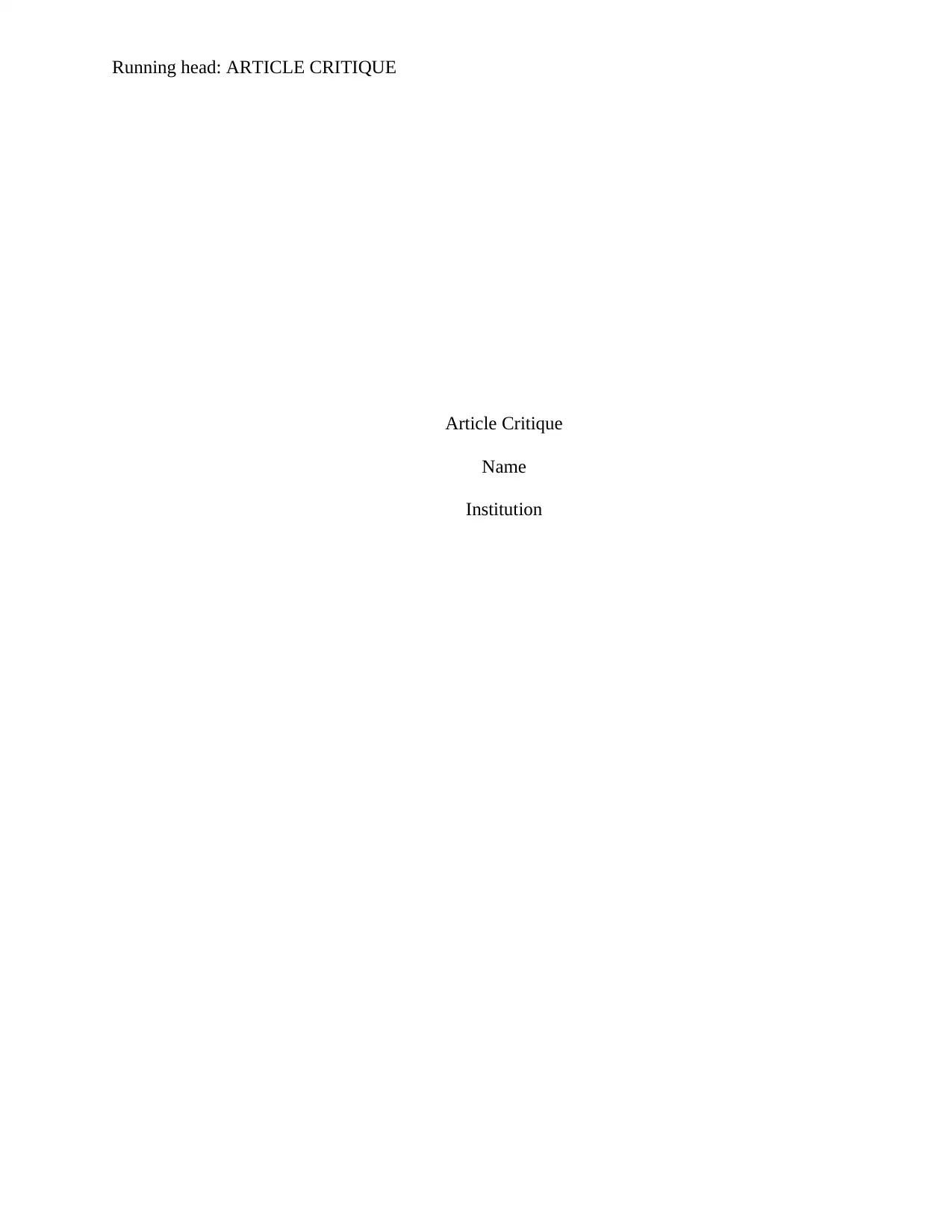
Running head: ARTICLE CRITIQUE
Article Critique
Name
Institution
Article Critique
Name
Institution
Paraphrase This Document
Need a fresh take? Get an instant paraphrase of this document with our AI Paraphraser
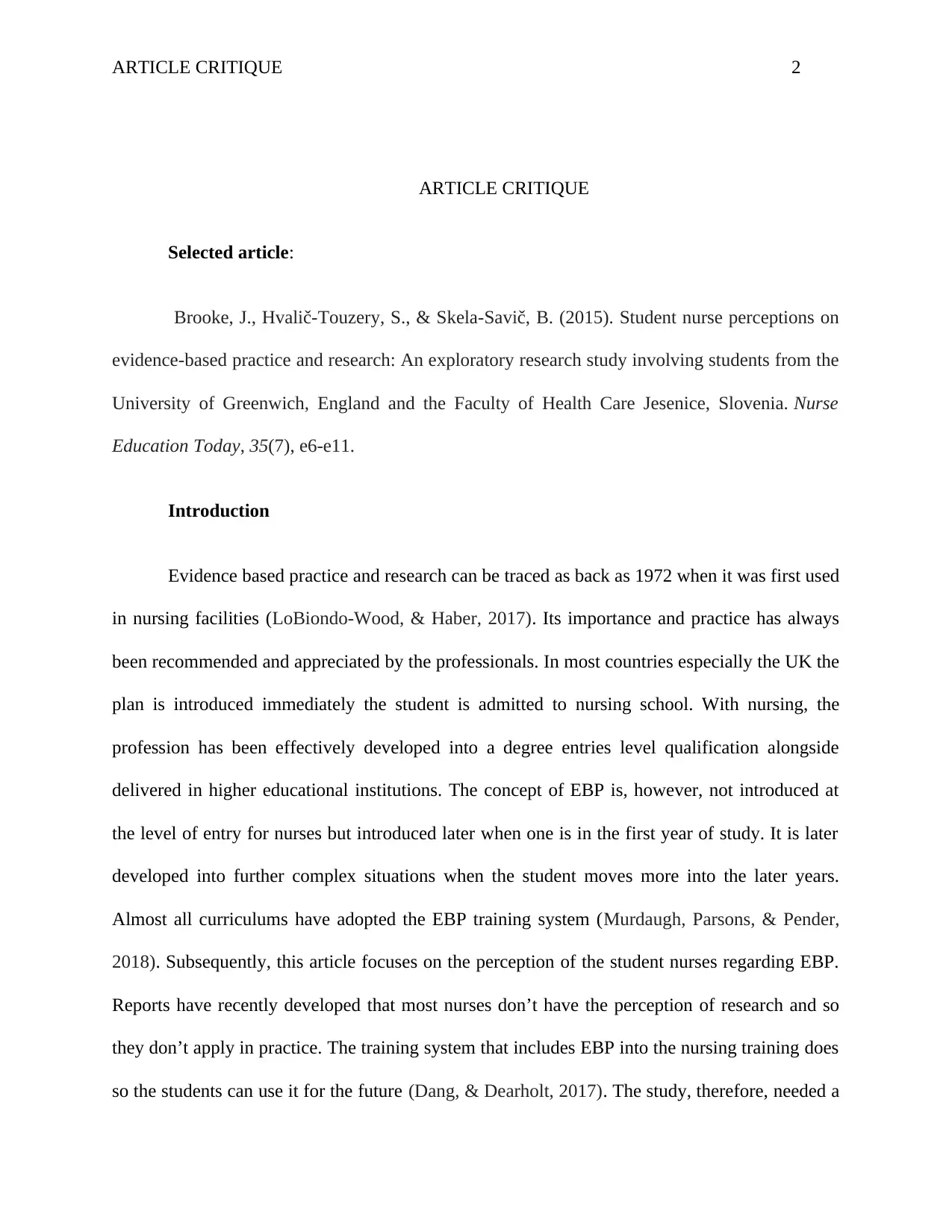
ARTICLE CRITIQUE 2
ARTICLE CRITIQUE
Selected article:
Brooke, J., Hvalič-Touzery, S., & Skela-Savič, B. (2015). Student nurse perceptions on
evidence-based practice and research: An exploratory research study involving students from the
University of Greenwich, England and the Faculty of Health Care Jesenice, Slovenia. Nurse
Education Today, 35(7), e6-e11.
Introduction
Evidence based practice and research can be traced as back as 1972 when it was first used
in nursing facilities (LoBiondo-Wood, & Haber, 2017). Its importance and practice has always
been recommended and appreciated by the professionals. In most countries especially the UK the
plan is introduced immediately the student is admitted to nursing school. With nursing, the
profession has been effectively developed into a degree entries level qualification alongside
delivered in higher educational institutions. The concept of EBP is, however, not introduced at
the level of entry for nurses but introduced later when one is in the first year of study. It is later
developed into further complex situations when the student moves more into the later years.
Almost all curriculums have adopted the EBP training system (Murdaugh, Parsons, & Pender,
2018). Subsequently, this article focuses on the perception of the student nurses regarding EBP.
Reports have recently developed that most nurses don’t have the perception of research and so
they don’t apply in practice. The training system that includes EBP into the nursing training does
so the students can use it for the future (Dang, & Dearholt, 2017). The study, therefore, needed a
ARTICLE CRITIQUE
Selected article:
Brooke, J., Hvalič-Touzery, S., & Skela-Savič, B. (2015). Student nurse perceptions on
evidence-based practice and research: An exploratory research study involving students from the
University of Greenwich, England and the Faculty of Health Care Jesenice, Slovenia. Nurse
Education Today, 35(7), e6-e11.
Introduction
Evidence based practice and research can be traced as back as 1972 when it was first used
in nursing facilities (LoBiondo-Wood, & Haber, 2017). Its importance and practice has always
been recommended and appreciated by the professionals. In most countries especially the UK the
plan is introduced immediately the student is admitted to nursing school. With nursing, the
profession has been effectively developed into a degree entries level qualification alongside
delivered in higher educational institutions. The concept of EBP is, however, not introduced at
the level of entry for nurses but introduced later when one is in the first year of study. It is later
developed into further complex situations when the student moves more into the later years.
Almost all curriculums have adopted the EBP training system (Murdaugh, Parsons, & Pender,
2018). Subsequently, this article focuses on the perception of the student nurses regarding EBP.
Reports have recently developed that most nurses don’t have the perception of research and so
they don’t apply in practice. The training system that includes EBP into the nursing training does
so the students can use it for the future (Dang, & Dearholt, 2017). The study, therefore, needed a
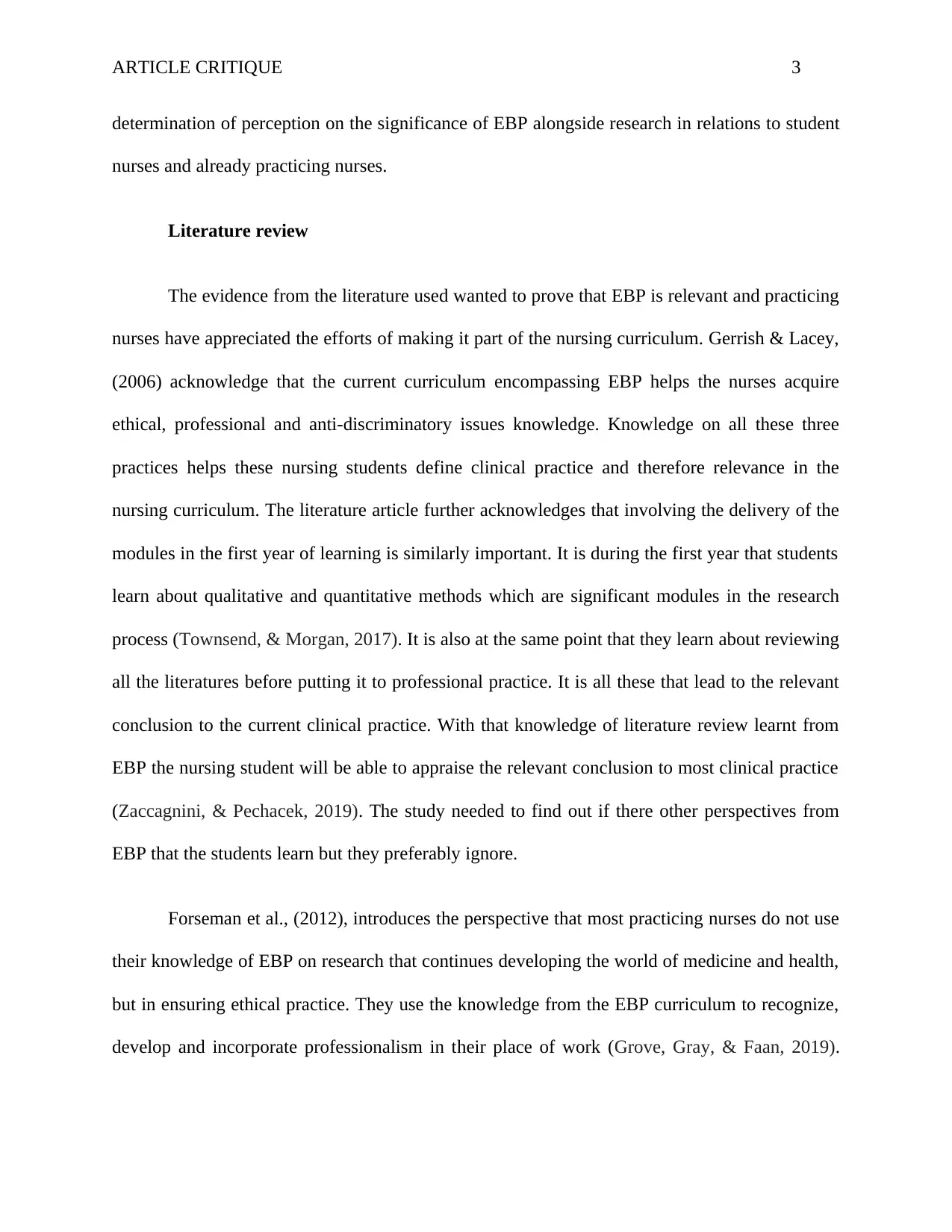
ARTICLE CRITIQUE 3
determination of perception on the significance of EBP alongside research in relations to student
nurses and already practicing nurses.
Literature review
The evidence from the literature used wanted to prove that EBP is relevant and practicing
nurses have appreciated the efforts of making it part of the nursing curriculum. Gerrish & Lacey,
(2006) acknowledge that the current curriculum encompassing EBP helps the nurses acquire
ethical, professional and anti-discriminatory issues knowledge. Knowledge on all these three
practices helps these nursing students define clinical practice and therefore relevance in the
nursing curriculum. The literature article further acknowledges that involving the delivery of the
modules in the first year of learning is similarly important. It is during the first year that students
learn about qualitative and quantitative methods which are significant modules in the research
process (Townsend, & Morgan, 2017). It is also at the same point that they learn about reviewing
all the literatures before putting it to professional practice. It is all these that lead to the relevant
conclusion to the current clinical practice. With that knowledge of literature review learnt from
EBP the nursing student will be able to appraise the relevant conclusion to most clinical practice
(Zaccagnini, & Pechacek, 2019). The study needed to find out if there other perspectives from
EBP that the students learn but they preferably ignore.
Forseman et al., (2012), introduces the perspective that most practicing nurses do not use
their knowledge of EBP on research that continues developing the world of medicine and health,
but in ensuring ethical practice. They use the knowledge from the EBP curriculum to recognize,
develop and incorporate professionalism in their place of work (Grove, Gray, & Faan, 2019).
determination of perception on the significance of EBP alongside research in relations to student
nurses and already practicing nurses.
Literature review
The evidence from the literature used wanted to prove that EBP is relevant and practicing
nurses have appreciated the efforts of making it part of the nursing curriculum. Gerrish & Lacey,
(2006) acknowledge that the current curriculum encompassing EBP helps the nurses acquire
ethical, professional and anti-discriminatory issues knowledge. Knowledge on all these three
practices helps these nursing students define clinical practice and therefore relevance in the
nursing curriculum. The literature article further acknowledges that involving the delivery of the
modules in the first year of learning is similarly important. It is during the first year that students
learn about qualitative and quantitative methods which are significant modules in the research
process (Townsend, & Morgan, 2017). It is also at the same point that they learn about reviewing
all the literatures before putting it to professional practice. It is all these that lead to the relevant
conclusion to the current clinical practice. With that knowledge of literature review learnt from
EBP the nursing student will be able to appraise the relevant conclusion to most clinical practice
(Zaccagnini, & Pechacek, 2019). The study needed to find out if there other perspectives from
EBP that the students learn but they preferably ignore.
Forseman et al., (2012), introduces the perspective that most practicing nurses do not use
their knowledge of EBP on research that continues developing the world of medicine and health,
but in ensuring ethical practice. They use the knowledge from the EBP curriculum to recognize,
develop and incorporate professionalism in their place of work (Grove, Gray, & Faan, 2019).
⊘ This is a preview!⊘
Do you want full access?
Subscribe today to unlock all pages.

Trusted by 1+ million students worldwide
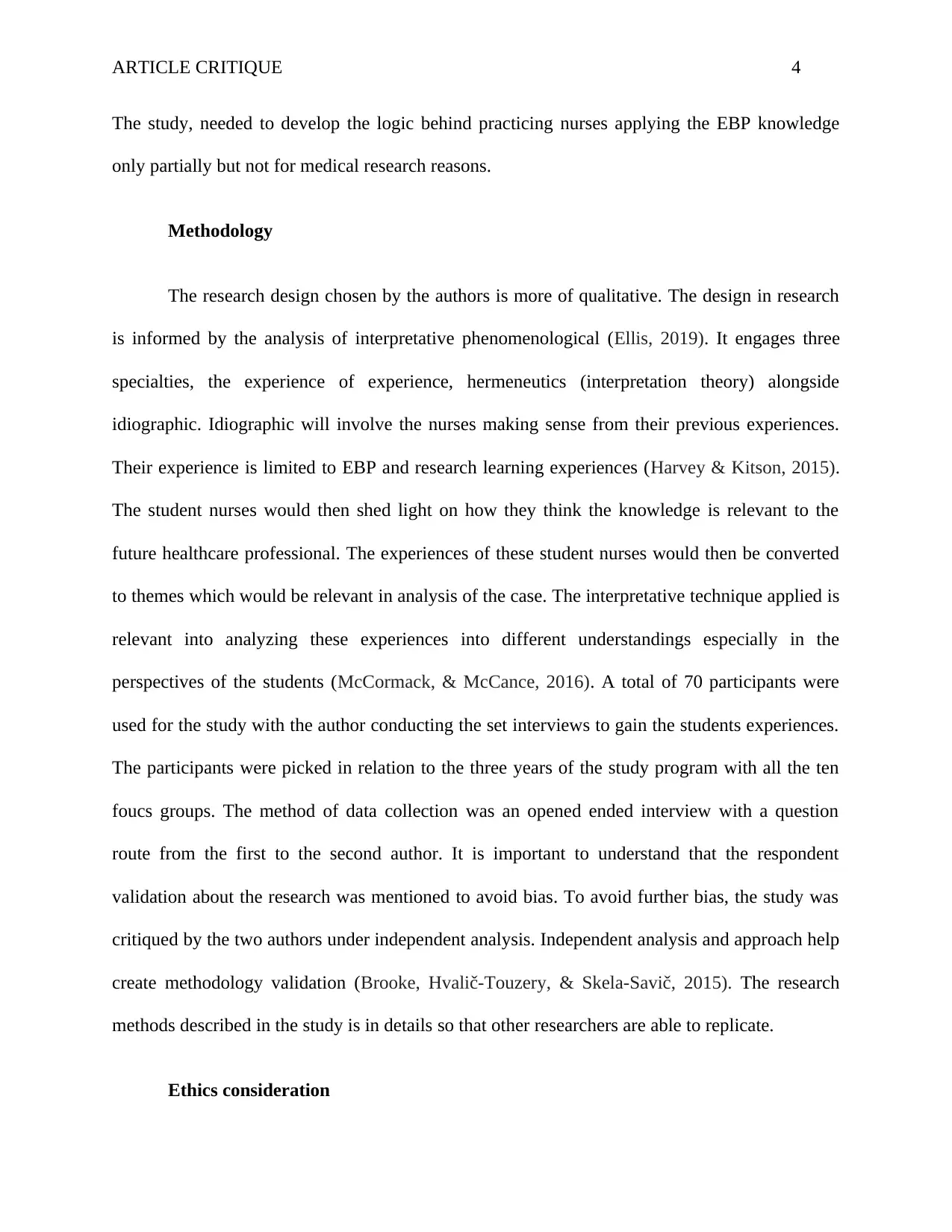
ARTICLE CRITIQUE 4
The study, needed to develop the logic behind practicing nurses applying the EBP knowledge
only partially but not for medical research reasons.
Methodology
The research design chosen by the authors is more of qualitative. The design in research
is informed by the analysis of interpretative phenomenological (Ellis, 2019). It engages three
specialties, the experience of experience, hermeneutics (interpretation theory) alongside
idiographic. Idiographic will involve the nurses making sense from their previous experiences.
Their experience is limited to EBP and research learning experiences (Harvey & Kitson, 2015).
The student nurses would then shed light on how they think the knowledge is relevant to the
future healthcare professional. The experiences of these student nurses would then be converted
to themes which would be relevant in analysis of the case. The interpretative technique applied is
relevant into analyzing these experiences into different understandings especially in the
perspectives of the students (McCormack, & McCance, 2016). A total of 70 participants were
used for the study with the author conducting the set interviews to gain the students experiences.
The participants were picked in relation to the three years of the study program with all the ten
foucs groups. The method of data collection was an opened ended interview with a question
route from the first to the second author. It is important to understand that the respondent
validation about the research was mentioned to avoid bias. To avoid further bias, the study was
critiqued by the two authors under independent analysis. Independent analysis and approach help
create methodology validation (Brooke, Hvalič-Touzery, & Skela-Savič, 2015). The research
methods described in the study is in details so that other researchers are able to replicate.
Ethics consideration
The study, needed to develop the logic behind practicing nurses applying the EBP knowledge
only partially but not for medical research reasons.
Methodology
The research design chosen by the authors is more of qualitative. The design in research
is informed by the analysis of interpretative phenomenological (Ellis, 2019). It engages three
specialties, the experience of experience, hermeneutics (interpretation theory) alongside
idiographic. Idiographic will involve the nurses making sense from their previous experiences.
Their experience is limited to EBP and research learning experiences (Harvey & Kitson, 2015).
The student nurses would then shed light on how they think the knowledge is relevant to the
future healthcare professional. The experiences of these student nurses would then be converted
to themes which would be relevant in analysis of the case. The interpretative technique applied is
relevant into analyzing these experiences into different understandings especially in the
perspectives of the students (McCormack, & McCance, 2016). A total of 70 participants were
used for the study with the author conducting the set interviews to gain the students experiences.
The participants were picked in relation to the three years of the study program with all the ten
foucs groups. The method of data collection was an opened ended interview with a question
route from the first to the second author. It is important to understand that the respondent
validation about the research was mentioned to avoid bias. To avoid further bias, the study was
critiqued by the two authors under independent analysis. Independent analysis and approach help
create methodology validation (Brooke, Hvalič-Touzery, & Skela-Savič, 2015). The research
methods described in the study is in details so that other researchers are able to replicate.
Ethics consideration
Paraphrase This Document
Need a fresh take? Get an instant paraphrase of this document with our AI Paraphraser
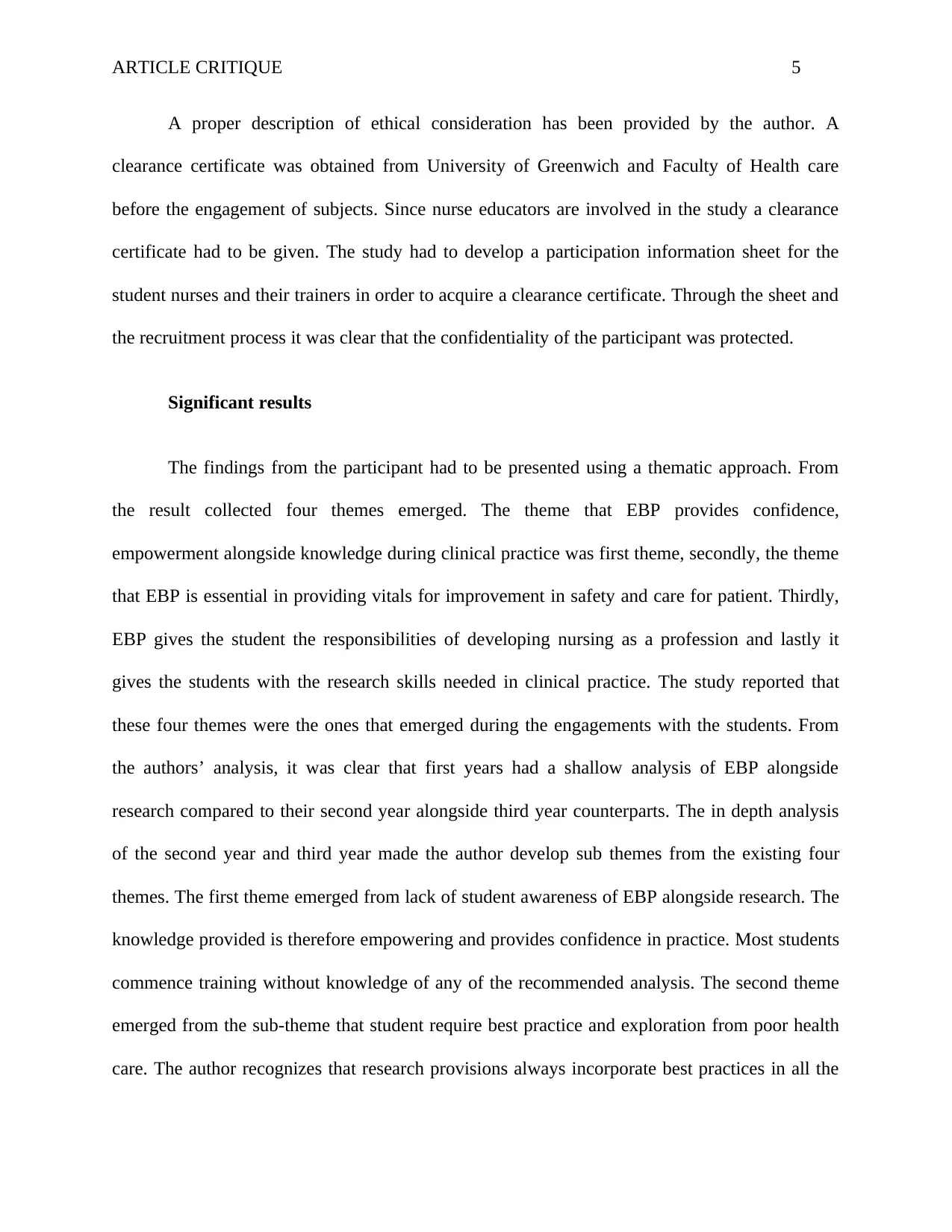
ARTICLE CRITIQUE 5
A proper description of ethical consideration has been provided by the author. A
clearance certificate was obtained from University of Greenwich and Faculty of Health care
before the engagement of subjects. Since nurse educators are involved in the study a clearance
certificate had to be given. The study had to develop a participation information sheet for the
student nurses and their trainers in order to acquire a clearance certificate. Through the sheet and
the recruitment process it was clear that the confidentiality of the participant was protected.
Significant results
The findings from the participant had to be presented using a thematic approach. From
the result collected four themes emerged. The theme that EBP provides confidence,
empowerment alongside knowledge during clinical practice was first theme, secondly, the theme
that EBP is essential in providing vitals for improvement in safety and care for patient. Thirdly,
EBP gives the student the responsibilities of developing nursing as a profession and lastly it
gives the students with the research skills needed in clinical practice. The study reported that
these four themes were the ones that emerged during the engagements with the students. From
the authors’ analysis, it was clear that first years had a shallow analysis of EBP alongside
research compared to their second year alongside third year counterparts. The in depth analysis
of the second year and third year made the author develop sub themes from the existing four
themes. The first theme emerged from lack of student awareness of EBP alongside research. The
knowledge provided is therefore empowering and provides confidence in practice. Most students
commence training without knowledge of any of the recommended analysis. The second theme
emerged from the sub-theme that student require best practice and exploration from poor health
care. The author recognizes that research provisions always incorporate best practices in all the
A proper description of ethical consideration has been provided by the author. A
clearance certificate was obtained from University of Greenwich and Faculty of Health care
before the engagement of subjects. Since nurse educators are involved in the study a clearance
certificate had to be given. The study had to develop a participation information sheet for the
student nurses and their trainers in order to acquire a clearance certificate. Through the sheet and
the recruitment process it was clear that the confidentiality of the participant was protected.
Significant results
The findings from the participant had to be presented using a thematic approach. From
the result collected four themes emerged. The theme that EBP provides confidence,
empowerment alongside knowledge during clinical practice was first theme, secondly, the theme
that EBP is essential in providing vitals for improvement in safety and care for patient. Thirdly,
EBP gives the student the responsibilities of developing nursing as a profession and lastly it
gives the students with the research skills needed in clinical practice. The study reported that
these four themes were the ones that emerged during the engagements with the students. From
the authors’ analysis, it was clear that first years had a shallow analysis of EBP alongside
research compared to their second year alongside third year counterparts. The in depth analysis
of the second year and third year made the author develop sub themes from the existing four
themes. The first theme emerged from lack of student awareness of EBP alongside research. The
knowledge provided is therefore empowering and provides confidence in practice. Most students
commence training without knowledge of any of the recommended analysis. The second theme
emerged from the sub-theme that student require best practice and exploration from poor health
care. The author recognizes that research provisions always incorporate best practices in all the
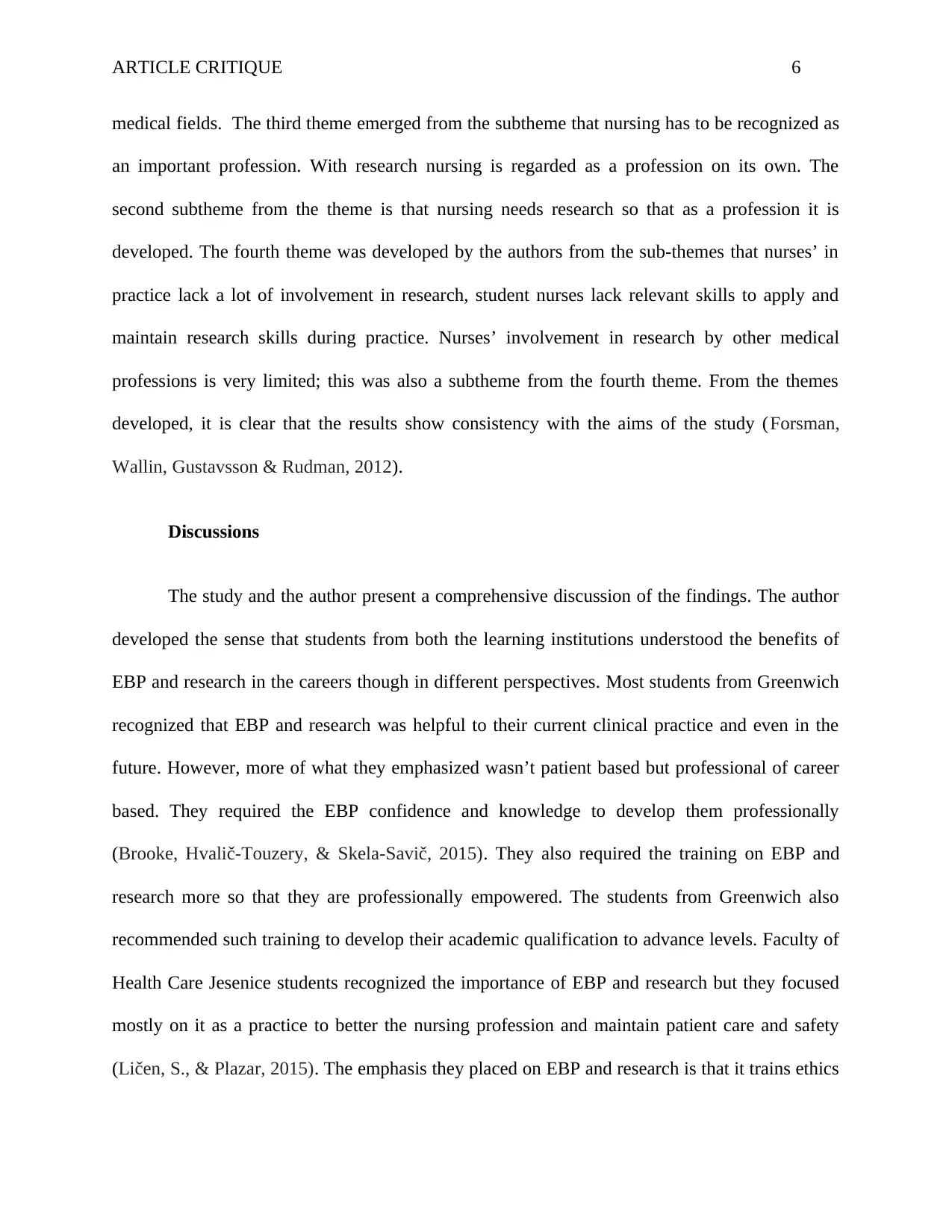
ARTICLE CRITIQUE 6
medical fields. The third theme emerged from the subtheme that nursing has to be recognized as
an important profession. With research nursing is regarded as a profession on its own. The
second subtheme from the theme is that nursing needs research so that as a profession it is
developed. The fourth theme was developed by the authors from the sub-themes that nurses’ in
practice lack a lot of involvement in research, student nurses lack relevant skills to apply and
maintain research skills during practice. Nurses’ involvement in research by other medical
professions is very limited; this was also a subtheme from the fourth theme. From the themes
developed, it is clear that the results show consistency with the aims of the study (Forsman,
Wallin, Gustavsson & Rudman, 2012).
Discussions
The study and the author present a comprehensive discussion of the findings. The author
developed the sense that students from both the learning institutions understood the benefits of
EBP and research in the careers though in different perspectives. Most students from Greenwich
recognized that EBP and research was helpful to their current clinical practice and even in the
future. However, more of what they emphasized wasn’t patient based but professional of career
based. They required the EBP confidence and knowledge to develop them professionally
(Brooke, Hvalič-Touzery, & Skela-Savič, 2015). They also required the training on EBP and
research more so that they are professionally empowered. The students from Greenwich also
recommended such training to develop their academic qualification to advance levels. Faculty of
Health Care Jesenice students recognized the importance of EBP and research but they focused
mostly on it as a practice to better the nursing profession and maintain patient care and safety
(Ličen, S., & Plazar, 2015). The emphasis they placed on EBP and research is that it trains ethics
medical fields. The third theme emerged from the subtheme that nursing has to be recognized as
an important profession. With research nursing is regarded as a profession on its own. The
second subtheme from the theme is that nursing needs research so that as a profession it is
developed. The fourth theme was developed by the authors from the sub-themes that nurses’ in
practice lack a lot of involvement in research, student nurses lack relevant skills to apply and
maintain research skills during practice. Nurses’ involvement in research by other medical
professions is very limited; this was also a subtheme from the fourth theme. From the themes
developed, it is clear that the results show consistency with the aims of the study (Forsman,
Wallin, Gustavsson & Rudman, 2012).
Discussions
The study and the author present a comprehensive discussion of the findings. The author
developed the sense that students from both the learning institutions understood the benefits of
EBP and research in the careers though in different perspectives. Most students from Greenwich
recognized that EBP and research was helpful to their current clinical practice and even in the
future. However, more of what they emphasized wasn’t patient based but professional of career
based. They required the EBP confidence and knowledge to develop them professionally
(Brooke, Hvalič-Touzery, & Skela-Savič, 2015). They also required the training on EBP and
research more so that they are professionally empowered. The students from Greenwich also
recommended such training to develop their academic qualification to advance levels. Faculty of
Health Care Jesenice students recognized the importance of EBP and research but they focused
mostly on it as a practice to better the nursing profession and maintain patient care and safety
(Ličen, S., & Plazar, 2015). The emphasis they placed on EBP and research is that it trains ethics
⊘ This is a preview!⊘
Do you want full access?
Subscribe today to unlock all pages.

Trusted by 1+ million students worldwide
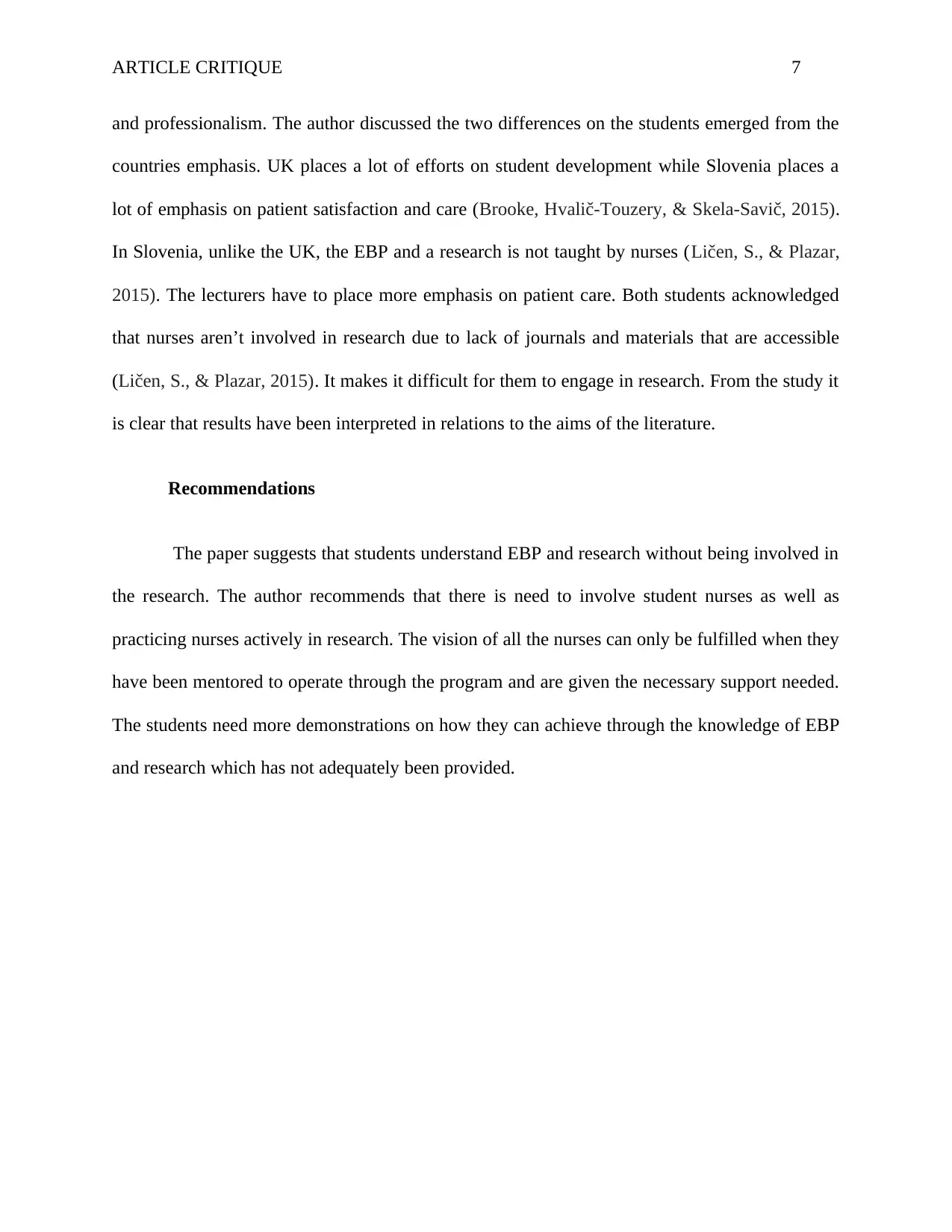
ARTICLE CRITIQUE 7
and professionalism. The author discussed the two differences on the students emerged from the
countries emphasis. UK places a lot of efforts on student development while Slovenia places a
lot of emphasis on patient satisfaction and care (Brooke, Hvalič-Touzery, & Skela-Savič, 2015).
In Slovenia, unlike the UK, the EBP and a research is not taught by nurses (Ličen, S., & Plazar,
2015). The lecturers have to place more emphasis on patient care. Both students acknowledged
that nurses aren’t involved in research due to lack of journals and materials that are accessible
(Ličen, S., & Plazar, 2015). It makes it difficult for them to engage in research. From the study it
is clear that results have been interpreted in relations to the aims of the literature.
Recommendations
The paper suggests that students understand EBP and research without being involved in
the research. The author recommends that there is need to involve student nurses as well as
practicing nurses actively in research. The vision of all the nurses can only be fulfilled when they
have been mentored to operate through the program and are given the necessary support needed.
The students need more demonstrations on how they can achieve through the knowledge of EBP
and research which has not adequately been provided.
and professionalism. The author discussed the two differences on the students emerged from the
countries emphasis. UK places a lot of efforts on student development while Slovenia places a
lot of emphasis on patient satisfaction and care (Brooke, Hvalič-Touzery, & Skela-Savič, 2015).
In Slovenia, unlike the UK, the EBP and a research is not taught by nurses (Ličen, S., & Plazar,
2015). The lecturers have to place more emphasis on patient care. Both students acknowledged
that nurses aren’t involved in research due to lack of journals and materials that are accessible
(Ličen, S., & Plazar, 2015). It makes it difficult for them to engage in research. From the study it
is clear that results have been interpreted in relations to the aims of the literature.
Recommendations
The paper suggests that students understand EBP and research without being involved in
the research. The author recommends that there is need to involve student nurses as well as
practicing nurses actively in research. The vision of all the nurses can only be fulfilled when they
have been mentored to operate through the program and are given the necessary support needed.
The students need more demonstrations on how they can achieve through the knowledge of EBP
and research which has not adequately been provided.
Paraphrase This Document
Need a fresh take? Get an instant paraphrase of this document with our AI Paraphraser
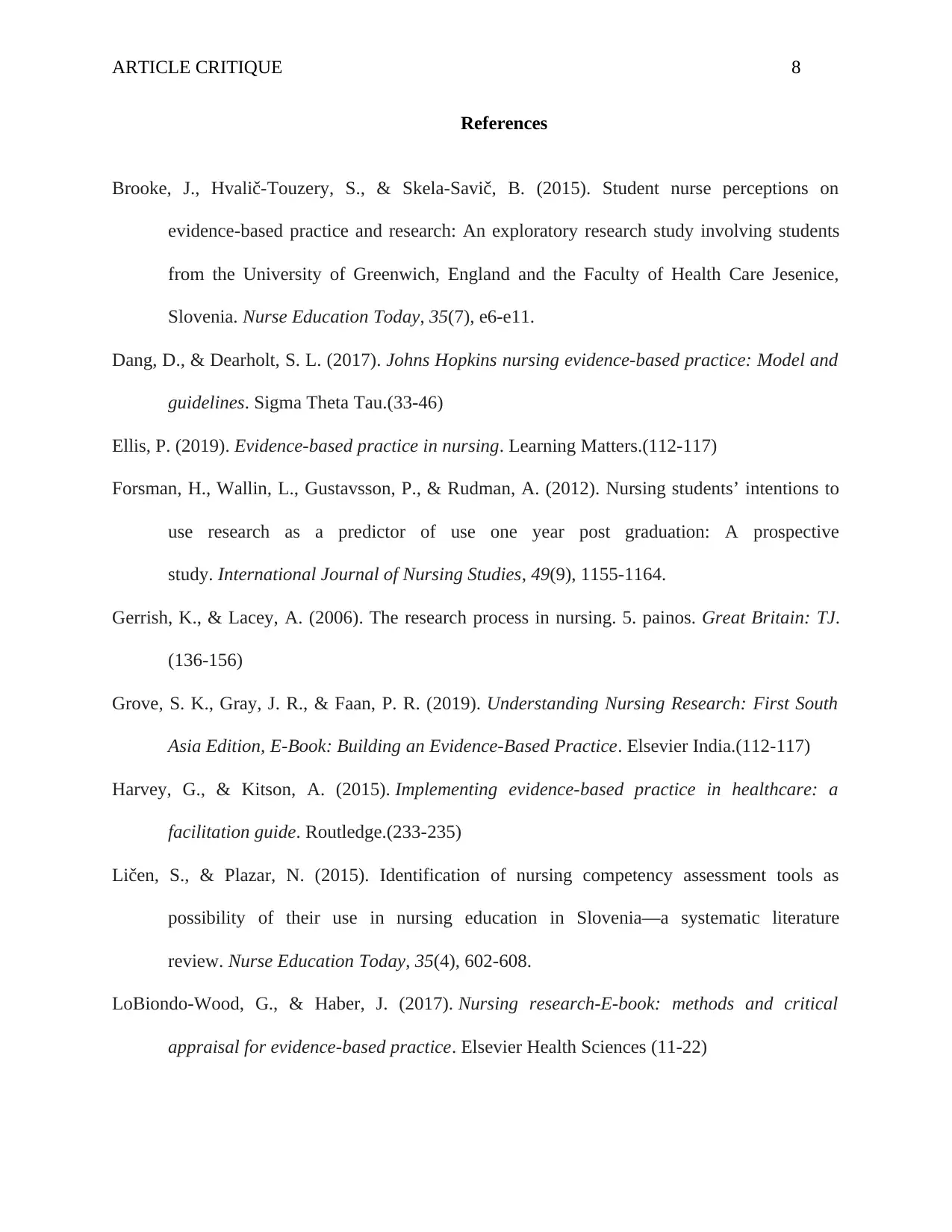
ARTICLE CRITIQUE 8
References
Brooke, J., Hvalič-Touzery, S., & Skela-Savič, B. (2015). Student nurse perceptions on
evidence-based practice and research: An exploratory research study involving students
from the University of Greenwich, England and the Faculty of Health Care Jesenice,
Slovenia. Nurse Education Today, 35(7), e6-e11.
Dang, D., & Dearholt, S. L. (2017). Johns Hopkins nursing evidence-based practice: Model and
guidelines. Sigma Theta Tau.(33-46)
Ellis, P. (2019). Evidence-based practice in nursing. Learning Matters.(112-117)
Forsman, H., Wallin, L., Gustavsson, P., & Rudman, A. (2012). Nursing students’ intentions to
use research as a predictor of use one year post graduation: A prospective
study. International Journal of Nursing Studies, 49(9), 1155-1164.
Gerrish, K., & Lacey, A. (2006). The research process in nursing. 5. painos. Great Britain: TJ.
(136-156)
Grove, S. K., Gray, J. R., & Faan, P. R. (2019). Understanding Nursing Research: First South
Asia Edition, E-Book: Building an Evidence-Based Practice. Elsevier India.(112-117)
Harvey, G., & Kitson, A. (2015). Implementing evidence-based practice in healthcare: a
facilitation guide. Routledge.(233-235)
Ličen, S., & Plazar, N. (2015). Identification of nursing competency assessment tools as
possibility of their use in nursing education in Slovenia—a systematic literature
review. Nurse Education Today, 35(4), 602-608.
LoBiondo-Wood, G., & Haber, J. (2017). Nursing research-E-book: methods and critical
appraisal for evidence-based practice. Elsevier Health Sciences (11-22)
References
Brooke, J., Hvalič-Touzery, S., & Skela-Savič, B. (2015). Student nurse perceptions on
evidence-based practice and research: An exploratory research study involving students
from the University of Greenwich, England and the Faculty of Health Care Jesenice,
Slovenia. Nurse Education Today, 35(7), e6-e11.
Dang, D., & Dearholt, S. L. (2017). Johns Hopkins nursing evidence-based practice: Model and
guidelines. Sigma Theta Tau.(33-46)
Ellis, P. (2019). Evidence-based practice in nursing. Learning Matters.(112-117)
Forsman, H., Wallin, L., Gustavsson, P., & Rudman, A. (2012). Nursing students’ intentions to
use research as a predictor of use one year post graduation: A prospective
study. International Journal of Nursing Studies, 49(9), 1155-1164.
Gerrish, K., & Lacey, A. (2006). The research process in nursing. 5. painos. Great Britain: TJ.
(136-156)
Grove, S. K., Gray, J. R., & Faan, P. R. (2019). Understanding Nursing Research: First South
Asia Edition, E-Book: Building an Evidence-Based Practice. Elsevier India.(112-117)
Harvey, G., & Kitson, A. (2015). Implementing evidence-based practice in healthcare: a
facilitation guide. Routledge.(233-235)
Ličen, S., & Plazar, N. (2015). Identification of nursing competency assessment tools as
possibility of their use in nursing education in Slovenia—a systematic literature
review. Nurse Education Today, 35(4), 602-608.
LoBiondo-Wood, G., & Haber, J. (2017). Nursing research-E-book: methods and critical
appraisal for evidence-based practice. Elsevier Health Sciences (11-22)
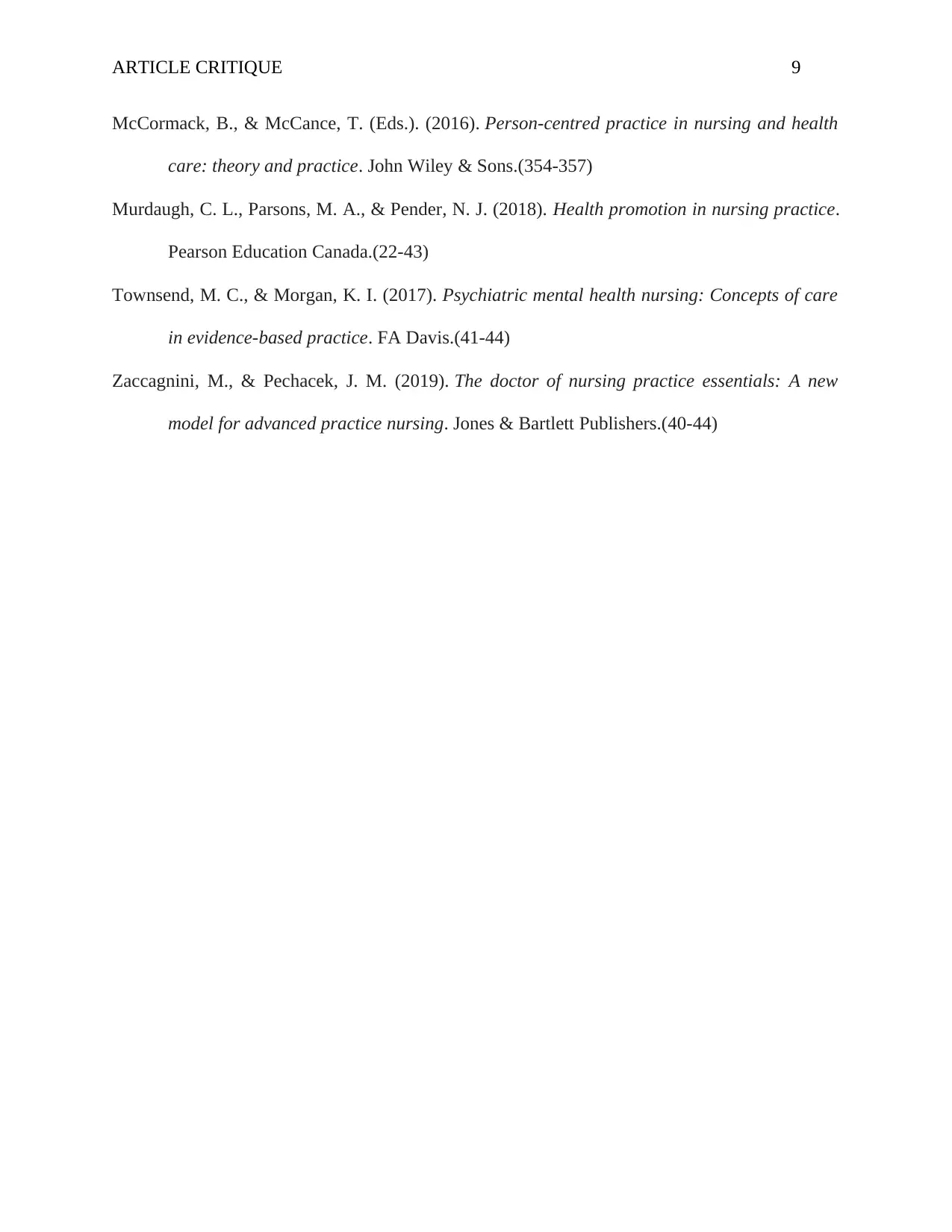
ARTICLE CRITIQUE 9
McCormack, B., & McCance, T. (Eds.). (2016). Person-centred practice in nursing and health
care: theory and practice. John Wiley & Sons.(354-357)
Murdaugh, C. L., Parsons, M. A., & Pender, N. J. (2018). Health promotion in nursing practice.
Pearson Education Canada.(22-43)
Townsend, M. C., & Morgan, K. I. (2017). Psychiatric mental health nursing: Concepts of care
in evidence-based practice. FA Davis.(41-44)
Zaccagnini, M., & Pechacek, J. M. (2019). The doctor of nursing practice essentials: A new
model for advanced practice nursing. Jones & Bartlett Publishers.(40-44)
McCormack, B., & McCance, T. (Eds.). (2016). Person-centred practice in nursing and health
care: theory and practice. John Wiley & Sons.(354-357)
Murdaugh, C. L., Parsons, M. A., & Pender, N. J. (2018). Health promotion in nursing practice.
Pearson Education Canada.(22-43)
Townsend, M. C., & Morgan, K. I. (2017). Psychiatric mental health nursing: Concepts of care
in evidence-based practice. FA Davis.(41-44)
Zaccagnini, M., & Pechacek, J. M. (2019). The doctor of nursing practice essentials: A new
model for advanced practice nursing. Jones & Bartlett Publishers.(40-44)
⊘ This is a preview!⊘
Do you want full access?
Subscribe today to unlock all pages.

Trusted by 1+ million students worldwide
1 out of 9
Related Documents
Your All-in-One AI-Powered Toolkit for Academic Success.
+13062052269
info@desklib.com
Available 24*7 on WhatsApp / Email
![[object Object]](/_next/static/media/star-bottom.7253800d.svg)
Unlock your academic potential
Copyright © 2020–2025 A2Z Services. All Rights Reserved. Developed and managed by ZUCOL.





